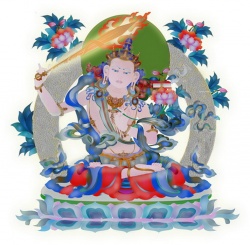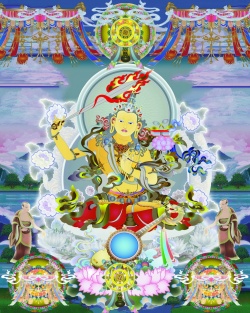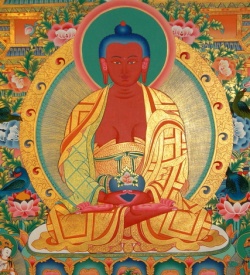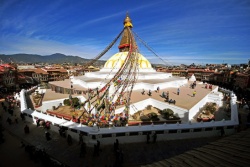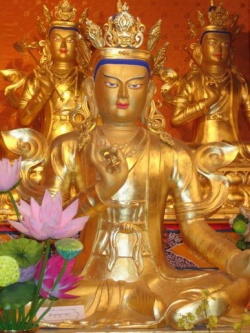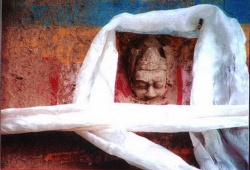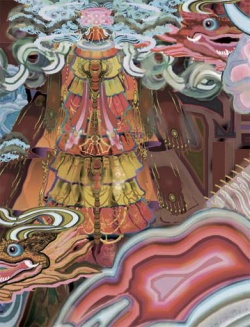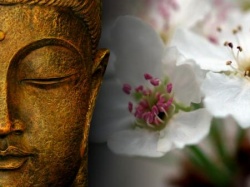Hundred Peaceful & Wrathful Deities
"The Hundred Peaceful and Wrathful Deities" originated from the Guhyagarbha Tantra ("The Tantra of the Secret Quintessence"), the main tantra of the Mahayoga class and the primary Tantric text studied in the Nyingma tradition.
The Guhyagarbha Tantra also carries the meaning of "destroying the roots of Vajra Hell", considered to be a compulsory practice for all Mahasiddhas and the great accomplished practitioners.
The Hundred Peaceful and Wrathful Deities include the forty-two peaceful deities and fifty-eight wrathful deities.
Bardo, the intermediate state between death and rebirth generally lasts "seven times seven days" or 49 days at the most.
At every stage, there is a the gradual emergence of a special mandala, emitting a variety of different dazzling glare of light and loud thundering roar.
As long as the one passing through the bardo state can recognize these different deities as the reflections of the nature of Dharmadhatu, covering all six realms, he or she can be liberated.
Vajrasattva, as an aspect of Samantabhadra, is the principal deity of the Guhyagarbha Tantra.
Besides the benefits mentioned earlier, the Vajra-wheel now engraved with the 100 deities, based on line drawings by His Holiness the Gyalwang Drukpa, will further give the following benefits, upon completion:
To liberate the suffering of those beings who have long taken rebirth in samsaric realms, including ancestors, parents, relatives and friends, and to plant the seed of enlightenment on their behalf.
To liberate those in the bardo state
To liberate the consciousness of the demonish spirits, so that they may take rebirth in Amitabha's pureland
To accumulate merit and wisdom for the living beings, and to purify the negative karma accumulated since beginning-less times, so that they will be free from sickness and away from all the natural and man made disasters, and their lives will be prolonged
The Hundred Peaceful and Wrathful Deities
Source: Rigpa Shedra
The 42 Peaceful Deities
Samantabadra
2 Samantabadri
3-7 The Five Male Buddhas of the Five Families — the five peaceful buddhas of the sambhogakaya:
Vairochana, buddha family
Akshobhya, vajra family
Ratnasambhava, ratna family
Amitabha, padma family
Amoghasiddhi, karma family
8-12 The Five Female Buddhas of the Five Families - also known as the five mothers:
Dhatvishvari, also known as Vajra Datvishvari or White Tara, the consort of Vairochana, who represents the purity of the element space
Buddhalochana, the consort of Akshobhya, who represents the purity of the element earth
Mamaki, the consort of Ratnasambhava, who represents the purity of the element water
Pandaravasini, the consort of Amitabha, who represents the purity of the element fire
Samayatara, also known as Green Tara, the consort of Amoghasiddhi, who represents the purity of the element wind
13-20 The Eight Male Bodhisattvas — the main bodhisattvas in the retinue of Buddha Shakyamuni:
Manjushri
Avalokiteshvara
Vajrapani
Maitreya
Kshitigarbha
Akashagarbha
Sarvanivaranavishkambhin
Samantabhadra
21-28 The Eight Female Bodhisattvas — also referred to as the eight offering goddesses.
They are the consorts of the eight great Bodhisattvas, symbolically representing the pure state of sense objects:
Goddess of Light, the consort of Manjushri
Goddess of Song, the consort of Avalokiteshvara
Goddess of Dance, the consort of Vajrapani
Goddess of Flowers, the consort of Maitreya
Goddess of Beauty, the consort of Kshitigarbha
Goddess of Garlands, the consort of Akashagarbha
Goddess of Incensee consort of Sarvanivaranavishkambhin
Goddess of Perfume, the consort of Samantabhadra
29-34 The Six Munis — the supreme Nirmanakaya Buddhas for each of the six classes of beings:
Indra Kaushika for the god realms
Vemachitra for the demi-gods or asura realms
Shakyamuni for the human realm
Shravasingha or Dhruvasiṃha for the animal realm
Jvalamukhadeva for the preta realms
Dharmaraja for the hell realms
35-38 The Four Male Gate Keepers:
Achala, guarding the east gate
Yamantaka, guarding the south gate
Hayagriva, guarding the west gate
Amritakundali, guarding the north gate
39-42 The Four Female Gate Keepers:
Ankusha, also called 'Horse Face' or 'Iron Hook', guarding the east gate and in union with Achala
Pasha, also called 'Sow Face' or 'the Noose', guarding the south gate and in union with Yamantaka
Shrinkhala, also called 'Lion Face' or 'Iron Chain', guarding the west gate and in union with Hayagriva
Ghanta, also called 'Wolf Face' or 'the Bell', guarding the north gate and in union with Amritakundali
The 58 Wrathful Deities
The Five Wrathful Herukas and their Five Consorts - the wrathful aspect of the male and female Buddhas of the five families:
Buddhaheruka and his consort Buddhakrodhishvari
Vajraheruka and his consort Vajrarodhishvari
Ratnaheruka and his consort Ratnarodhishvari
Padmaheruka and his consort Padmakrodhishvari
Karmaheruka and his consort Karmakrodhishvari
11-18 The Eight Wrathful Females:
Gauri
Pukkasi
Chaurimatrika
Ghasmari
Pramoha
Chandali
Vetali
Shmashani
19-26 The Eight Tramen - animal-headed deities:
Simhamukha
Vyaghrimukha
Srigalamukha
Shvanamukha
Gridhamukha
Kangkamukha
Kakamukha
[[Ulumukha]
27-30 The Four Female Gatekeepers:
Ankusha, also called 'Horse Face' or 'Iron Hook', guarding the east gate
Pasha, also called 'Sow Face' or 'the Noose', guarding the south gate
Shrinkhala, also called 'Lion Face' or 'Iron Chain', guarding the west gate
Ghanta, also called 'Wolf Face' or 'the Bell', guarding the north gate
31-58 The Twenty-eight Ishvaris - composed of four groups of six yoginis corresponding to the four activities, and of the four female outer-gate keepers:
The six yoginis corresponding to the activity of pacifying:
Rakshasi (white)
Brahmi
Mahadevi
Lobha
Kumari
Indrani
Vajra
Shanti
Amrita
Chandra
Danda
Rakshasi (dark yellow)
Bhakshini
Rati
Mahabala
Rakshasi (pale red)
Kama
Vasuraksha
Vayudevi
Nari
Varahi
Nanda
Mahahastini
Varunadevi
